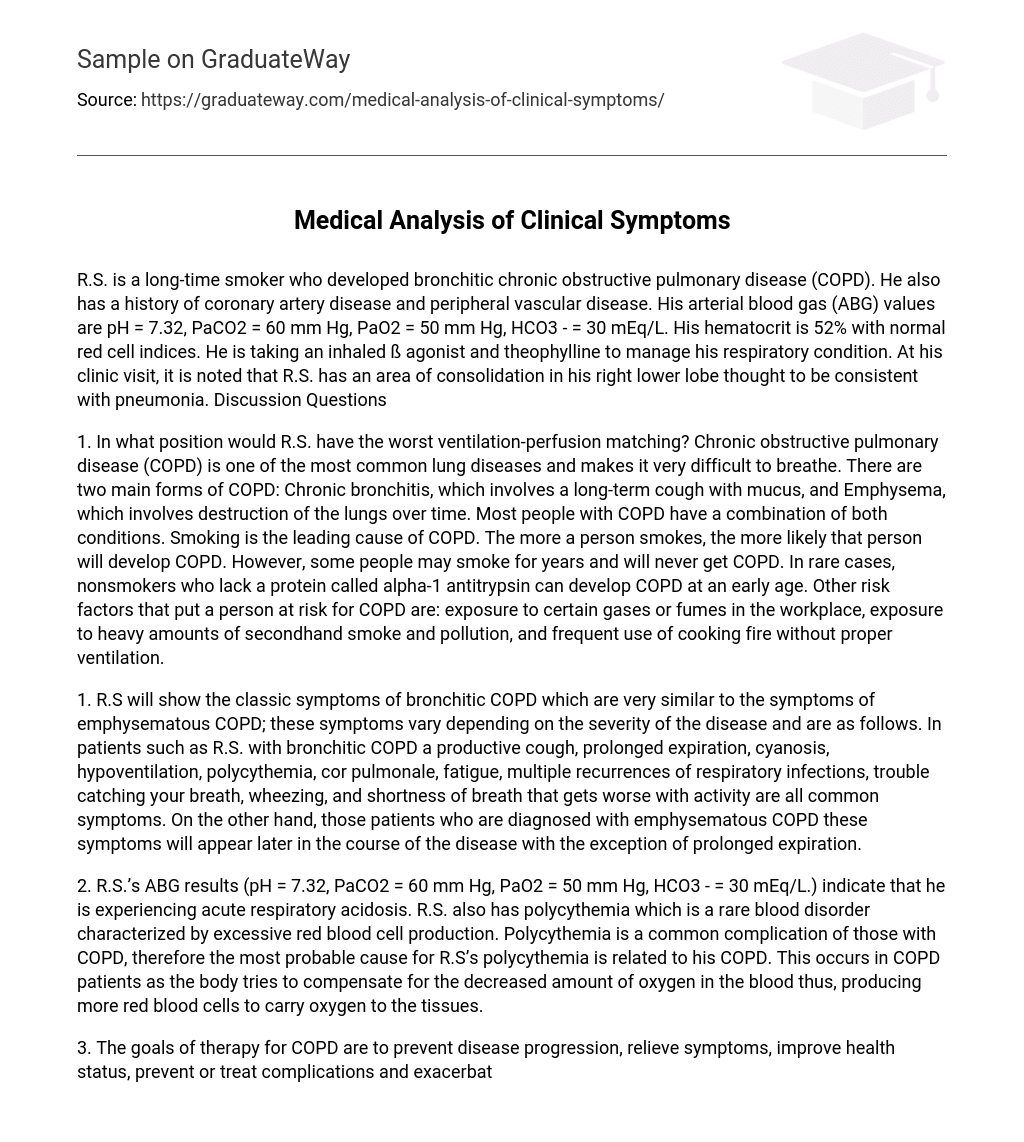R.S. is a long-time smoker who developed bronchitic chronic obstructive pulmonary disease (COPD). He also has a history of coronary artery disease and peripheral vascular disease. His arterial blood gas (ABG) values are pH = 7.32, PaCO2 = 60 mm Hg, PaO2 = 50 mm Hg, HCO3 – = 30 mEq/L. His hematocrit is 52% with normal red cell indices. He is taking an inhaled ß agonist and theophylline to manage his respiratory condition. At his clinic visit, it is noted that R.S. has an area of consolidation in his right lower lobe thought to be consistent with pneumonia. Discussion Questions
1. In what position would R.S. have the worst ventilation-perfusion matching? Chronic obstructive pulmonary disease (COPD) is one of the most common lung diseases and makes it very difficult to breathe. There are two main forms of COPD: Chronic bronchitis, which involves a long-term cough with mucus, and Emphysema, which involves destruction of the lungs over time. Most people with COPD have a combination of both conditions. Smoking is the leading cause of COPD. The more a person smokes, the more likely that person will develop COPD. However, some people may smoke for years and will never get COPD. In rare cases, nonsmokers who lack a protein called alpha-1 antitrypsin can develop COPD at an early age. Other risk factors that put a person at risk for COPD are: exposure to certain gases or fumes in the workplace, exposure to heavy amounts of secondhand smoke and pollution, and frequent use of cooking fire without proper ventilation.
1. R.S will show the classic symptoms of bronchitic COPD which are very similar to the symptoms of emphysematous COPD; these symptoms vary depending on the severity of the disease and are as follows. In patients such as R.S. with bronchitic COPD a productive cough, prolonged expiration, cyanosis, hypoventilation, polycythemia, cor pulmonale, fatigue, multiple recurrences of respiratory infections, trouble catching your breath, wheezing, and shortness of breath that gets worse with activity are all common symptoms. On the other hand, those patients who are diagnosed with emphysematous COPD these symptoms will appear later in the course of the disease with the exception of prolonged expiration.
2. R.S.’s ABG results (pH = 7.32, PaCO2 = 60 mm Hg, PaO2 = 50 mm Hg, HCO3 – = 30 mEq/L.) indicate that he is experiencing acute respiratory acidosis. R.S. also has polycythemia which is a rare blood disorder characterized by excessive red blood cell production. Polycythemia is a common complication of those with COPD, therefore the most probable cause for R.S’s polycythemia is related to his COPD. This occurs in COPD patients as the body tries to compensate for the decreased amount of oxygen in the blood thus, producing more red blood cells to carry oxygen to the tissues.
3. The goals of therapy for COPD are to prevent disease progression, relieve symptoms, improve health status, prevent or treat complications and exacerbations, and reduce morbidity. By combining pharmacologic therapy using Theophylline and a ß-agonist together to treat R.S.’s disease the goals of therapy can be accomplished. Theophylline is classified as a bronchodilator which can be used long-term to relieve airway obstruction in asthma, or in the case COPD. With proper teaching and use, theophylline will increase the ease of breathing and help clear the lung fields in R.S. Long-acting ß-agonists, such as salmeterol and formoterol are recommended for the management of moderate to severe COPD by the National Asthma Education and Prevention Program. Studies have shown that long-acting ß-agonists can decrease exacerbations and hospitalizations; improve symptoms, lung function, quality of life, and possibly mortality by providing the effects of a bronchodilator and an anti-inflammatory in the lungs. Treating R.S. using both Theophylline and a long-acting ß-agonist will allow R.S. to breathe easier, and prevent complications, therefore increasing his quality of life.
4. Although these medications can help improve R.S’s disease dramatically there are some cons associated with the use of them, as with many medications. For example, theophylline can cause life-threatening reactions in some patients such as arrhythmias, tachycardia, angina, and palpitations. Beta-agonist increases the risk for adverse cardiovascular events such as myocardial infarction, congestive heart failure, cardiac arrest, and acute cardiac death. Beta-agonist also increases heart rate and reduces potassium concentration. The risks involved with these medications should be compared
against the benefits of use in patients with COPD.
5. Ventilation-perfusion matching refers to a state of equilibrium within the respiratory system. The worst position for ventilation-perfusion matching for R.S. would be standing. Standing up is the worst position for ventilation-perfusion because gravity will drain the blood to the lowest part of the lungs, and pull the lungs down toward the diaphragm compressing their bases. The gases will rise to the upper portion of the lungs (apices) making the lungs more difficult to inflate, therefore making it more difficult to breathe.
Works Cited
Andrea Gershon, MD. (2011). Comparison of Inhaled Long-Acting Beta Agonist and Anticholinergic Effectiveness in Older Patients Wtih COPD. Annals of Internal Medicine, 583-592; W-204-W-215. Deglin, J. H. (2009). Davis’s Drug Guide. F.A. Davis Company. Retrieved January 2012 Golden, Christy RN, MSN, ACNP, AOCN. (2008). Polycythemia Vera: A Review. Clinical Journal of Oncology Nursing, 553-556. Huether, Sue E. , McCane, Kathryn L. (2012). Understanding Pathophysiology 5th Ed. St. Louis, MO: Elsevier Mosby. National Heart Lung and Blood Institute . (2012, June 08). What Are the Signs and Symptoms of COPD? Retrieved from National Heart Lung and Blood Institute: http://www.nhlbi.nih.gov/health/health-topics/topics/copd/signs.html





